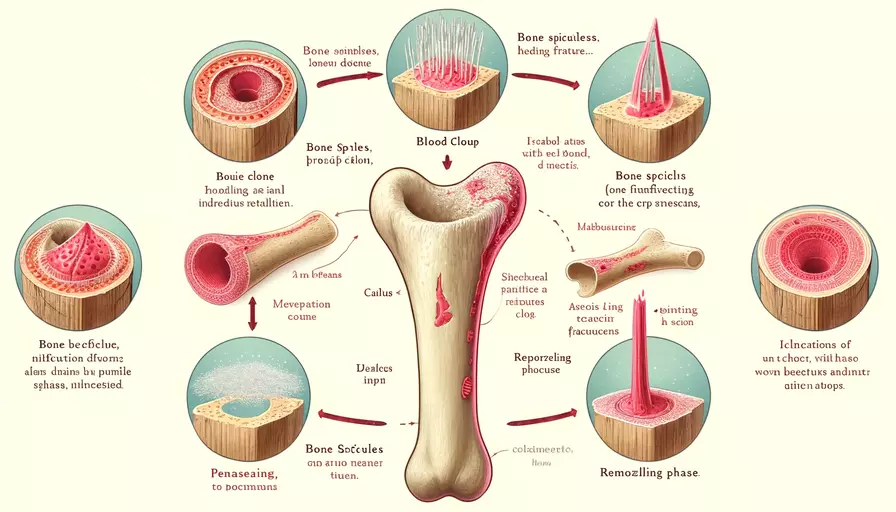Understanding Bone Spicules: Guide to Post-Tooth Extraction Care

Are you familiar with the lingering discomfort and uncertainty often following a tooth extraction procedure? It’s a common concern among individuals navigating the realm of post-extraction care. Our expert guide on bone spicules unveils a comprehensive roadmap to understanding and managing this intricate aspect of dental health.
From exploring the causes behind bone spicule formation to recognizing key symptoms and essential surgical procedures, we’ve provided a treasure trove of knowledge to facilitate a seamless recovery journey. Dive into the world of oral surgery, wisdom tooth extractions, and effective management strategies with us. Let’s embark on this enlightening journey towards optimal oral health and recovery post-tooth extraction.
- Understanding Bone Spicules After Tooth Extraction
- The Causes Behind Bone Spicules Formation
- Recognizing the Symptoms of Bone Spicule
- Essential Surgical Procedures for Prevention and Management
- Home Management Strategies for Bone Spicules
- Indicators to Seek Professional Dental Care
- Exploring Treatment Options and When Surgery Is Necessary
- The Healing Journey: Tips for a Swift Recovery
- Preventing Future Occurrences of Bone Spicules
- Understanding Your Dental Health: From Oral Surgery to Recovery
- The Role of Diet in the Healing Process
- Insights into Socket Preservation and Its Importance
- Personal Accounts: How Patients Have Managed Bone Spicules
- Expert Advice on Proper Post-Extraction Care
- Frequently Asked Questions About Bone Spicule
- Conclusion
Understanding Bone Spicules After Tooth Extraction
Bone spicules, or bone fragments, are small, sharp pieces of bone that can emerge at the extraction site following a tooth removal procedure. These tiny, irregular protrusions can cause discomfort and irritation to the surrounding soft tissue, making the healing process more challenging.
Imagine taking a bite of a crisp, juicy apple and suddenly feeling a sharp, stinging sensation in your gum where a tooth was recently extracted. A bone spicule, a familiar yet discomforting occurrence after dental surgeries such as wisdom tooth removal, often causes this sensation.
Understanding the nature of bone spicules is crucial for managing post-extraction care and ensuring a smooth recovery. By comprehending the underlying causes, recognizing the symptoms, and exploring available treatment options, one can proactively minimize discomfort and facilitate optimal healing.
💡 Key Takeaways: Bone spicules are small, sharp bone fragments that can emerge after tooth extraction, causing discomfort and requiring proper management for a smooth recovery.
The Causes Behind Bone Spicules Formation
Bone spicules typically form following tooth extractions, particularly after the removal of wisdom teeth. During the surgical procedure, small fragments of bone may break off and remain in the extraction site, forming bone spicules.
Additionally, healing after a tooth extraction involves the body’s natural remodeling of the jawbone. In some cases, this remodeling process can result in the emergence of small, sharp protrusions of bone, especially if a dental implant is planned for the future.
💡 Key Takeaways: Bone spicules form due to residual bone fragments and the body’s natural bone remodeling process after tooth extraction.
Recognizing the Symptoms of Bone Spicule
Identifying the presence of bone spicules is essential for timely management and pain relief. The most common sign of a bone spicule is a sharp, painful sensation in the extraction site, often felt when touching the area with your tongue or finger. Other symptoms may include:
- Visible sharp fragments of bone protruding from the gum tissue
- Significant discomfort or pain when eating or drinking
- Sensitivity to hot and cold temperatures
- Swelling or inflammation around the affected area
If you experience any of these symptoms following a tooth extraction, it’s crucial to contact your dentist or oral surgeon promptly. They can carefully assess the situation and advise the appropriate treatment to not only ease pain but also prevent the onset of further complications.
💡 Key Takeaways: Sharp pain, visible bone fragments, and significant discomfort are common signs of bone spicules that require prompt dental attention.
Essential Surgical Procedures for Prevention and Management
Dental professionals may employ specific surgical procedures to minimize the risk of bone spicules and ensure proper healing after tooth extraction. Two such procedures are alveoloplasty and socket preservation.
Alveoloplasty: Reshaping the Bone
Alveoloplasty is a surgical procedure that involves smoothing and reshaping the bone at the extraction site. By removing any sharp edges or irregularities, alveoloplasty reduces the likelihood of bone spicules forming and promotes a more comfortable healing process.
For example, suppose you have a wisdom tooth removed. In that case, your oral surgeon may perform alveoloplasty to contour the bone and create a smoother surface, minimizing the risk of bone spicules and facilitating proper healing.
Socket Preservation: Maintaining Bone Structure
Socket preservation is another surgical technique that helps maintain the structure of the alveolar ridge, the bony ridge that supports the teeth. This method involves grafting bone material into the tooth extraction area to stop bone loss and create a strong base for future dental implants.
By preserving the socket and preventing bone deterioration, socket preservation reduces the chances of bone spicules forming and ensures optimal bone health for potential dental restorations.
💡 Key Takeaways: Alveoloplasty and socket preservation are surgical procedures that help prevent bone spicules, promote proper healing, and maintain bone structure after tooth extraction.
Home Management Strategies for Bone Spicules
If a bone spicule is troubling you, consider these effective home treatment strategies to alleviate discomfort and enhance healing:
- Regularly rinsing the affected area with warm salt water can help reduce any swelling and keep the extraction site clean.
- Apply an ice pack to the external cheek area to significantly reduce swelling and numb the surrounding pain.
- Embrace a soft-food diet to avoid irritating the delicate extraction site or dislodging the protective blood clot.
- Use recommended over-the-counter pain relievers as per your dentist’s guidance to manage the pain effectively.
💡 Key Takeaways: Warm salt water rinses, ice packs, a soft diet, and pain medication can help manage bone spicules at home.
Indicators to Seek Professional Dental Care
While home management can provide relief, there are certain situations where seeking professional dental care is necessary. If you experience any of the following, contact your oral surgeon or complete an online booking form for prompt treatment:
- Pain that doesn’t go away or gets worse with home care
- Symptoms of infection, such as a fever, noticeable swelling, or discharge emanating from the extraction site
- Difficulty opening your mouth or swallowing
- Prolonged bleeding or the formation of a dental bone spur
💡 Key Takeaways: Severe pain, infection signs, or the development of a dental bone spur warrant immediate professional dental care.
Exploring Treatment Options and When Surgery Is Necessary
Treatment for bone spicules depends on the severity of symptoms and the extent of the bony protrusion. In some cases, conservative management, such as the earlier home strategies, may be sufficient to alleviate discomfort and allow the bone spur to smoothen over time.
However, surgical removal may be necessary if the bone spicule causes significant discomfort or interferes with healing. During this procedure, the oral surgeon will numb the area and carefully remove the dental bone spicule, ensuring a smoother surface for proper healing.
Your dental professional will assess your unique situation and suggest the most suitable treatment plan, taking into account variables like the size and placement of the bony protrusion as well as the overall state of your oral health.
💡 Key Takeaways: Treatment for bone spicules ranges from conservative management to surgical removal, depending on symptom severity and healing progression.
The Healing Journey: Tips for a Swift Recovery
- To heal quickly after tooth extraction and lower the risk of bone spicules, follow these steps:
- Follow your post-surgery instructions carefully, including taking your medicines and cleaning your mouth.
- Avoid smoking and using straws, as they can remove the blood clot and slow down healing.
- Gently rinse the extraction site with warm salt water to clean the area and help alleviate any swelling.
- Start eating solid foods slowly, choosing soft foods at first.
- Go to all your follow-up dentist appointments to check how well you are healing and talk about any concerns.
💡 Key Takeaways: Following post-operative instructions, maintaining oral hygiene, and attending follow-up appointments are critical to a swift recovery after tooth extraction.
Preventing Future Occurrences of Bone Spicules
While bone spicules are pretty common after getting a tooth pulled, you can do a few things to help prevent them in the future:
- Keep good mouth-cleaning habits, like brushing twice daily and flossing regularly.
- Scheduling regular dental appointments and professional cleanings will enable your dentist to closely track the condition of your oral hygiene and promptly address any problems that arise.
- If you require wisdom tooth removal or other oral surgery, choose a reputable and experienced oral surgeon who employs techniques to minimize bone damage and promote proper healing.
- Follow your dental professional’s recommendations for post-extraction care and attend follow-up appointments as scheduled.
💡 Key Takeaways: Good oral hygiene, regular dental check-ups, and choosing an experienced oral surgeon can help prevent future occurrences of bone spicules.
Understanding Your Dental Health: From Oral Surgery to Recovery
Understanding dental health can be hard, especially regarding oral surgeries like tooth extractions. By understanding the various aspects of your dental journey, from surgical procedures to recovery, you can feel more empowered and prepared to manage potential side effects like bone spicules.
Remember, each person’s experience with oral surgery is unique, and you must communicate openly with your dental professional about any concerns or questions. They’re here to provide you with customized guidance and continuous support, ensuring your treatment and recovery process is as smooth as possible.
Whether undergoing wisdom tooth removal or another oral surgery, being informed about the process and potential complications can help you approach the experience confidently and safely. Being proactive about your oral health and getting treatment when needed can also help you achieve a healthy, bright smile more easily.
💡 Key Takeaways: Understanding the various aspects of oral surgery and recovery, combined with open communication with your dental professional, can help you confidently navigate your dental health journey and achieve optimal results.
The Role of Diet in the Healing Process
Eating the right foods is important for healing well after a tooth is pulled. For the first few days, stick to a soft, liquid-based diet, gradually introducing more solid foods as the extraction site heals.
Choose nutrient-rich options like smoothies, soups, and pureed fruits and vegetables to support your body’s recovery. Remember to avoid hot beverages, foods, and crunchy or hard items that could irritate the extraction site or dislodge the blood clot.
💡 Key Takeaways: A soft, nutritious diet promotes healing after tooth extraction.
Insights into Socket Preservation and Its Importance
Socket preservation is a valuable surgical technique that helps maintain the integrity of the alveolar ridge following tooth extraction. By placing bone grafting material into the extraction socket, socket preservation prevents bone loss and preserves the structure of the jawbone’s ridge.
Taking good care of your oral health and getting treatment quickly when needed can help you have a healthy, bright smile. It ensures a stable foundation for the implant and promotes optimal aesthetic and functional results.
💡 Key Takeaways: Socket preservation maintains alveolar ridge structure and prevents bone loss, making it a crucial procedure for future dental implants.
Personal Accounts: How Patients Have Managed Bone Spicules
Learning from people who have faced the same problems can give you helpful tips and make you feel more secure. Many patients have successfully managed bone spicules through home care and professional treatment.
For instance, 28-year-old Sarah was able to manage her discomfort following her wisdom teeth extraction by rinsing with warm salt water and taking the pain medication recommended by her dentist. When the discomfort persisted, she sought professional care and underwent a minor surgical procedure to remove the bone spicule, which allowed for proper healing and a swift recovery.
💡 Key Takeaways: Patients have managed bone spicules through home care and professional treatment, highlighting the importance of seeking dental care when necessary.
Expert Advice on Proper Post-Extraction Care
To ensure a seamless recovery and avoid complications like bone spicules, it’s essential to follow the post-extraction care instructions provided by your oral surgeon. These tips may include:
- Biting on a gauze pad regularly can significantly control bleeding and help form a clot—key steps to a smooth healing process.
- Avoiding smoking, using straws, or spitting forcefully to prevent dislodging the blood clot
- Rinse the area where your tooth was pulled with warm salt water to keep it clean and help with swelling.
- Take your prescribed pain medicine and antibiotics as told
- Make sure to visit all your follow-up appointments to check your healing.
💡 Key Takeaways: Following your oral surgeon’s post-extraction care instructions is crucial for a swift recovery and minimizing the risk of complications.
Frequently Asked Questions About Bone Spicule
What is a bone spicule?
A bone spicule is a small, sharp fragment of bone that can emerge at the tooth extraction site, causing discomfort and irritation to the surrounding gum tissue.
How common are bone spicules after tooth extraction?
Bone spicules are relatively common after tooth extractions, particularly after wisdom teeth removal. However, their frequency and severity can vary from person to person.
How can I tell if I have a bone spicule?
The most common signs of a bone spicule include a sharp or painful sensation at the extraction site, visible bone fragments protruding from the gum, and significant discomfort when eating or drinking.
When should I seek professional help for a bone spicule?
If you encounter intense pain, indications of infection, or ongoing discomfort that does not improve with self-care techniques, you should promptly contact your dentist or oral surgeon to receive professional medical attention.
Can bone spicules go away on their own?
Yes, sometimes small bone spicules can smooth out on their own as the area heals.
Are bone spicules dangerous?
Bone spicules are not dangerous but can be uncomfortable if they poke your gums. Your dentist can easily remove them if needed.
How common are bone spicules after extractions?
They are fairly common, especially after removing larger teeth like molars or wisdom teeth.
What causes bone spicules to form?
Bone spicules are typically formed during bone growth or healing processes, such as after a fracture or during dental developments like tooth eruption or extraction.
Are bone spicules a sign of any serious health condition?
While bone spicules themselves are not usually a sign of a serious health condition, their presence, especially in the gums after dental surgery, may require attention to prevent discomfort and infection.
How long does it take for bone spicules to resolve on their own?
Bone spicules that emerge in the gums after tooth extraction often resolve on their own within a few weeks as the mouth heals, but if they cause significant discomfort or do not resolve, dental intervention may be necessary.
Can bone spicules affect orthodontic treatments?
Bone spicules can sometimes emerge during orthodontic treatments, especially those involving tooth extractions. An orthodontist or dentist usually manages bone spicules to ensure they do not interfere with the treatment or appliance.
What should I do if I find a bone spicule protruding from my gums?
If you discover a bone spicule protruding from your gums, it’s best to consult your dentist. The dental professional can safely remove the protruding fragment and provide guidance on proper care to facilitate healing and avert infection.
Conclusion
In conclusion, navigating post-tooth extraction care and bone spicules demands a blend of awareness and proactive management strategies. Understanding the intricacies of bone spicules after dental procedures is crucial for a smooth recovery journey. From recognizing the subtle symptoms to exploring preventive surgical options, this expert guide equips you with comprehensive knowledge to take charge of your oral health.
Implementing home care techniques like warm salt water rinses and adhering to post-operative instructions are pivotal in ensuring optimal healing. Remember, your dental well-being is a priority, and seeking professional care when needed is critical to addressing any concerns promptly. Embrace the healing process with diligence and care, as each step contributes to a swift recovery and sets the foundation for long-term dental health. Let this guide be your companion on the path to post-extraction wellness, empowering you to make informed decisions for a brighter, healthier smile.






